I recently had the pleasure of reading Peter Stearns’ Fat History: Bodies and Beauty in the Modern West. The book chronicles the shift in American history from a plump to a thin ideal. The beauty of Stearns’ book is his resistance to reducing the shift in norms to a simple cause. Instead, he traces the changes to conflicts between capitalism and religion, the backlash against women’s equality, industrialization and the devaluation of maternal roles, fashion trends, the professionalization of medicine, our cultural relationship to food, and more.
Stearns is quite specific in timing the change, however, pointing to the years between 1890 and 1910. In these 20 years, he writes:
…middle-class America began its ongoing battle aginst body fat. Never previously an item of systemic public concern, dieting or guilt about not dieting became an increasing staple of private life, along with a surprisingly strong current of disgust directed against people labeled obese.
I thought of Stearns’ book when I came across a delightful collection of photographs of exotic dancers taken in 1890, the year he pinpoints as the beginning of the shift to thinness. From a contemporary perspective, they would likely be judged as “too fat,” but their plumpness was exactly what made these dancers so desirable at the time.
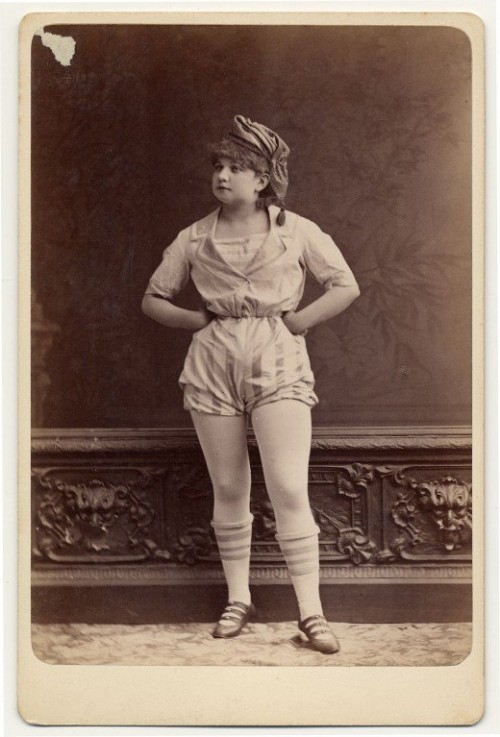
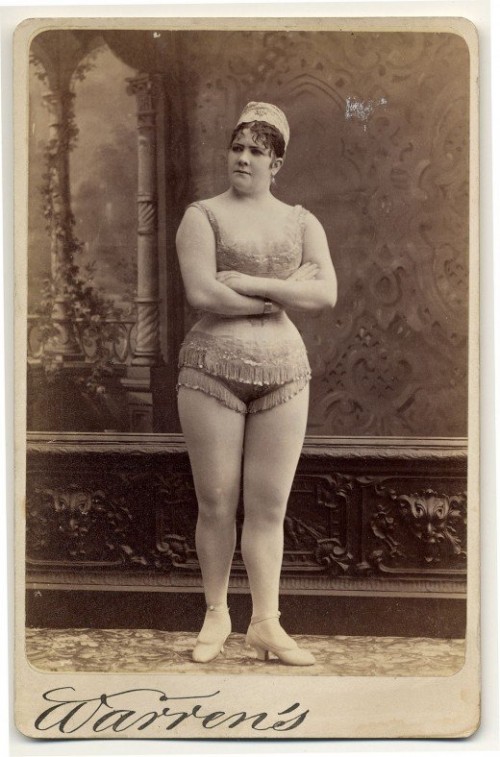
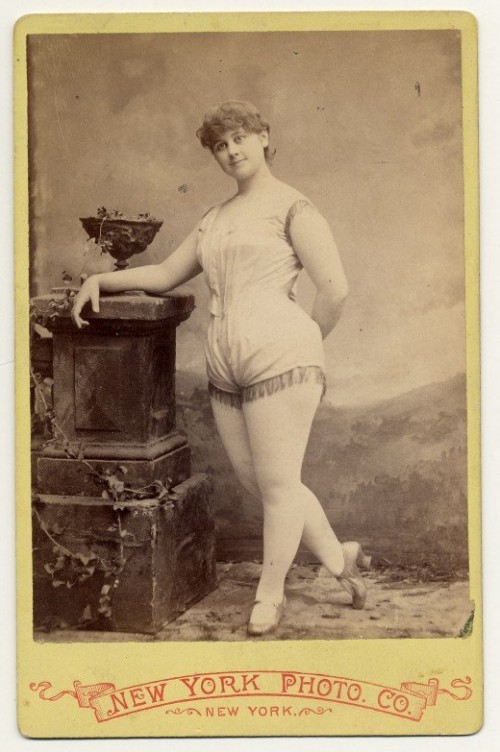
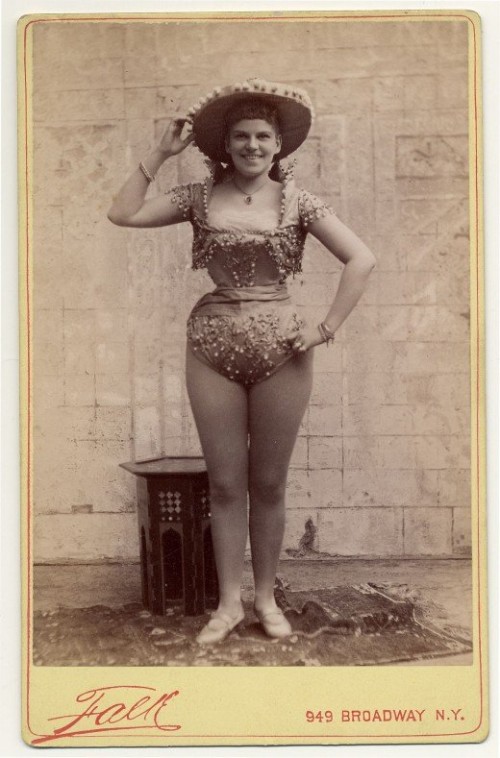
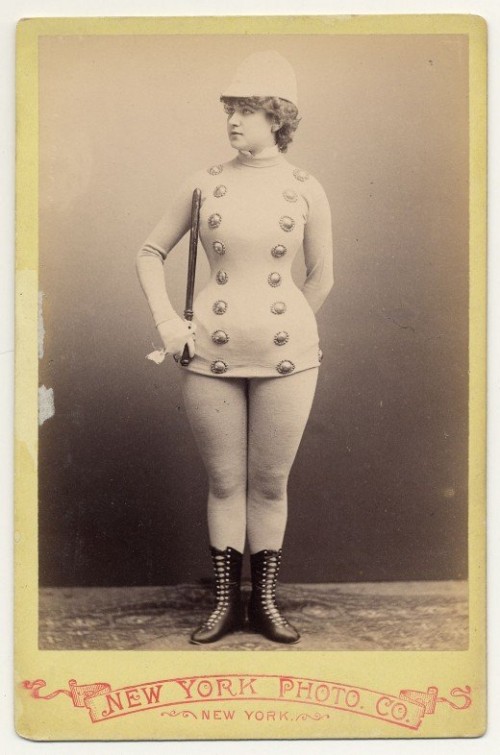
More at Retronaut.
Lisa Wade, PhD is an Associate Professor at Tulane University. She is the author of American Hookup, a book about college sexual culture; a textbook about gender; and a forthcoming introductory text: Terrible Magnificent Sociology. You can follow her on Twitter and Instagram.
Comments 101
Katya — March 7, 2012
Plump, but with a definite hourglass shape, and I'm not sure any of these women would be considered obese. Certainly, for a long time, a woman was supposed to be a little plump or curvy--it signaled health and sufficient income to eat well--but I'm not sure that truly obese people were ever considered really attractive in Western culture.
Ernest Valdemar — March 7, 2012
I am oddly charmed by the existence of an 1890s "sexy cop" costume. I can't help but imagine a "dude" in a derby hat, sack suit, and high-button shoes who has a thing for custodian helmets and brass buttons.
cee — March 7, 2012
What strikes me about these pictures (and, indeed, about many from that era) is how the idealized female is so juvenile looking.
While youth is typically idealized, today's beauty template is the leggy/gawky early adolescent. The ringlets, baby fat-style plumpness and dimples of the turn of the previous century evoke a child closer to three or four.
Coupling these very young features with exaggerated corseted waists is particularly strange to my modern eye.
anon — March 7, 2012
Positively contrived skinny-bashing BS.
Anonymous — March 7, 2012
It is also important to remember that photo retouching existed in the 1880's -- so while many of these performers appear to have exaggerated figures (small waist to hip ratio) that they may have been helped out by the photographer's paint brush. The woman in the sombrero type hat has an especially suspect looking waist shape on her right side.
Yes, these performers do have round faces, plump arms and thick legs -- the standard of beauty for the ideal feminine shape has varied considerably. Think 1880 v.s. 1920 v.s. 1960 v.s. 2000 -- there is a pretty extreme range. The only thing that has remained consistent is that the women are white -- and young.
Exotic Dancers of the 1890′s. « fait avec — March 7, 2012
[...] Dancers, 1890′s at Retronaut. Via Sociological Images‘ post Exptic Dancers in 1890 and the Plump Body Ideal Like this:LikeBe the first to like this [...]
Anonymous — March 7, 2012
Beauty is in the eye of the beholder
Heather Bryce — March 7, 2012
"One of the gals is fat and pink and pretty,
As round above as she was round below.
I swear that she was padded from her shoulder to her heel
But then she started dancin and her dancin made me feel
That every single thing she had was absolutely real..."
Reut Gelblum — March 8, 2012
Excuse me, these exotic dancers' figure is astonishing (aka not a creation of nature), but WAY more important- they are all white!!! What exactly is exotic about them, besides their being not completely dressed...?
DNLee — March 8, 2012
They were thick!
Anonymous — March 8, 2012
"From a contemporary perspective, they would likely be judged as “too fat,”"
Too fat for whom? Because honestly, I don't think that by an average American's standards, these woman would be considered "fat," unless you were asking a 14 year old boy or maybe a model search company. The third picture is the only one who I'd considered "chubby." Too fat to be exotic dancers? For all the fucked up beauty standards issues I hear from my friends who work as dancers, including fat shaming, not a single one of these woman would be barred from the stage. These women are not "fat" by any standards I've ever experienced, except maybe runway models and actresses. Now I know that in California and New England, there tends to be this overarching obsession among middle class white people with emulating actresses and models, but that's not necessarily true, at least not to the same degree, of any other demographic I'm familiar with. And once again, there are pictures of women being celebrated for being "different" from what we consider the norm today, yet they differ in only one aspect: weight. They're all white, with an hourglass figure (yes, achieved by a corset), and girlish faces. Any other differences between them and Marilyn Monroe, or Megan Fox is due to shifting changes in makeup and hair trends, not shifting beauty image trends.
Andrea — March 8, 2012
One interesting (and non-size related) thing that I noticed about these pictures is that they don't look off balance. I've read other posts here about how often women in modern advertisements or magazines are pictured off-balance in some way or another. Most of these women are planted solidly on their feet.
Alex51324 — March 8, 2012
I'm interested in the facial expressions. Many of the women are posed to appear to be looking at something off-camera, which is surprising to me since it suggests that they are interested in things other than the (male) viewer.
Those that are looking at the camera (such as the woman in the sombrero in the third picture here, or the woman in the black costume, 17th from the top at Retronaut) are doing so in a way that, to me, looks very frank, rather than coy.
A number of others are *facing* the camera, but have their eyes pointed
somewhere else, which is almost the opposite of what you see today,
where women presented as sexy tend to have their faces at an angle to
the camera, but their eyes turned toward it.
I don't know what to make of these observations, but that's what I find interesting.
Sharing the love « The Lady Garden — March 9, 2012
[...] for this week’s pretty, you might enjoy some 1890s cards of exotic dancers, over at Sociological Images. -40.352306 175.608215 Share this:TwitterFacebookEmailLike [...]
The Pinterest Problem | SociologyFocus — March 29, 2012
[...] Throughout history, the idea of what is sexy has changed. What do you think of these images ( http://thesocietypages.org/socimages/2012/03/07/exotic-dancers-in-1890-and-the-plump-body-ideal/ ) of desirable erotic dancers in the 1890s? Would these women be deemed to large by today’s [...]
Anonymous — April 2, 2012
This weight thing is tiresome...it was really bad to be a fat boy in the '50's, then in 60' >>>2000, it was easy to be lean...now I'm old & gain weight too easy & resent people pointing out I've gained weight...I know I have, but they hold it out as an 'approved' insult to me. And it simply is an insult.
The Plump Beauty Ideal: Exotic Dancers in 1890 | BroadBlogs — April 25, 2012
[...] Check out this post by Lisa Wade @ Sociological Images [...]
Exotic Dancers of 1890s | MEDIA DISSECTION — March 18, 2013
[...] Exotic Dancers of 1890s [...]
You Can Buy More Beer In China | Subversive Cooking — April 30, 2013
[...] a long-standing preference for what used to be called “pleasingly plump” women shifted from between time this image of a burlesque dancer was taken in the [...]
guest — July 29, 2013
The size, in length, interests me. I'm twice their height.
How to Build The Perfect Body: A Discussion on Body Image | NewsFitness.net — December 10, 2013
[…] on that last few pounds because “true beauty includes a full figure.” Or take these photos of dancers from the 1890′s, an ideal the mainstream media would no doubt consider “plump” by today’s […]
How to Build The Perfect Body: A Discussion on Body Image | Nerd Fitness — December 16, 2013
[…] on that last few pounds because “true beauty includes a full figure.” Or take these photos of dancers from the 1890′s, an ideal the mainstream media would no doubt consider “plump” by today’s […]
How to Build The Perfect Body: A Discussion on Body Image | Insane Muscle Gains — December 27, 2013
[…] that last few pounds because “true beauty includes a full figure.” Or take these photos of dancers from the 1890′s, an ideal the mainstream media would no doubt consider “plump” by today’s […]
How to Build The Perfect Body: A Discussion on Body Image | Zlata Sushchik — January 3, 2014
[…] put on that last few pounds because “true beauty includes a full figure.” Or take these photos of dancers from the 1890′s, an ideal the mainstream media would no doubt consider “plump” by today’s […]
Fatphobia: A Guide for the Disbeliever | Miss Kitty Stryker — April 25, 2014
[…] 5. The belief that “personal preference” exists above and beyond cultural norms is ignorant First, let me show you these graphs which suggest what the average BMIs are around the world. Then let’s add in that in some cultures being fat is seen as attractive. And let’s add in how beauty is often defined by wealthy white standards, creating unrealistic expectations for, well, everyone else. Finally, how about the fact that as we culturally began to freak out about fat… we got fatter? How did that work? Anyway, it seems pretty clear that “personal preference” is related more to cultural norms than to some biological urge. And this manifests in how we date, how we’re received, and how people treat our partners. It even manifests in our attraction to other fat people. This is a cultural construct. And it’s not even a consistent one here- look at these exotic dancers! […]
Fatphobia: A Guide for the Disbeliever | TOTALENTER10 — May 5, 2014
[…] 5. The belief that “personal preference” exists above and beyond cultural norms is ignorant. First, let me show you these graphs which suggest what the average BMIs are around the world. Then let’s add in that in some cultures being fat is seen as attractive. And let’s add in how beauty is often defined by wealthy white standards, creating unrealistic expectations for, well, everyone else. Finally, how about the fact that as we culturally began to freak out about fat… we got fatter? How did that work? Anyway, it seems pretty clear that “personal preference” is related more to cultural norms than to some biological urge. And this manifests in how we date, how we’re received, and how people treat our partners. It even manifests in our attraction to other fat people. This is a cultural construct. And it’s not even a consistent one here — look at these exotic dancers! […]
Fatphobia: A Guide For The Disbeliever | sexynewz.com — May 6, 2014
[…] First, let me show you these graphs which suggest what the average BMIs are around the world. Then let’s add in that in some cultures being fat is seen as attractive. And let’s add in how beauty is often defined by wealthy white standards, creating unrealistic expectations for, well, everyone else. Finally, how about the fact that as we culturally began to freak out about fat … we got fatter? How did that work? Anyway, it seems pretty clear that “personal preference” is related more to cultural norms than to some biological urge. And this manifests in how we date, how we’re received, and how people treat our partners. It even manifests in our attraction to other fat people. This is a cultural construct. And it’s not even a consistent one here — look at these exotic dancers! […]
Fatphobia: A Guide For The Disbeliever | — May 6, 2014
[…] First, let me show you these graphs which suggest what the average BMIs are around the world. Then let’s add in that in some cultures being fat is seen as attractive. And let’s add in how beauty is often defined by wealthy white standards, creating unrealistic expectations for, well, everyone else. Finally, how about the fact that as we culturally began to freak out about fat … we got fatter? How did that work? Anyway, it seems pretty clear that “personal preference” is related more to cultural norms than to some biological urge. And this manifests in how we date, how we’re received, and how people treat our partners. It even manifests in our attraction to other fat people. This is a cultural construct. And it’s not even a consistent one here — look at these exotic dancers! […]
acropunk — May 6, 2014
Its a matter of physics. More petite women and those with less weight tend to be more acrobatic in bed. But I am always suspicious of ideals. I find more plump body types attractive as well as more slender. It takes extremes of thin and fat to veer into unattractiveness for me.
Exotic Dancers in 1890 and the Plump Body Ideal | The FAT experience — May 9, 2014
[…] I thought of Stearns’ book when I came across a delightful collection of photographs of exotic dancers taken in 1890, the year he pinpoints as the beginning of the shift to thinness. From a contemporary perspective, they would likely be judged as “too fat,” but their plumpness was exactly what made these dancers so desirable at the time. http://thesocietypages.org/socimages/2012/03/07/exotic-dancers-in-1890-and-the-plump-body-ideal/ […]
Fatphobia: 5 Facts and a Guide for the Disbeliever — Everyday Feminism — October 19, 2014
[…] This is a cultural construct. And it’s not even a consistent one here — look at these exotic dancers! […]